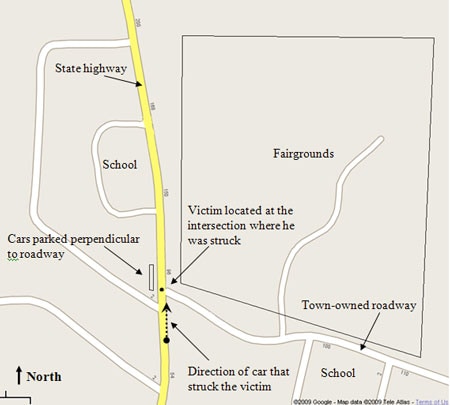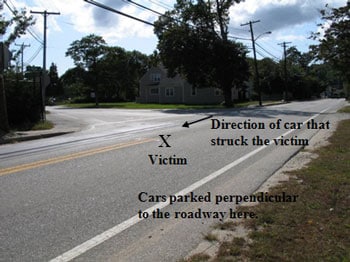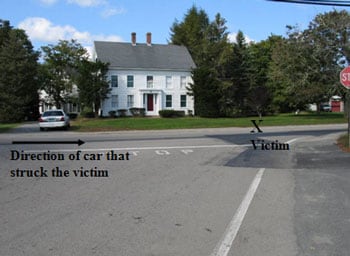Police Officer Dies when Struck by a Car at Night while Directing Traffic at a Local Fair - Massachusetts
Massachusetts Case Report: 08-MA-037
Release Date: September 24, 2009
Summary
On August 16, 2008, a 67-year-old male police officer (victim) was fatally injured when struck by a car while performing a traffic detail. The victim was directing traffic at night for a local annual fair and had been stationed at a T-shaped intersection close to the fairground’s main entrance. Property owners along this and other roadways near the fairgrounds are allowed, with a permit obtained from the town, to charge fair attendees to park on their lawns and property. At the time of the incident, the victim had stopped all traffic at the intersection to allow a car parked on a lawn adjacent to the intersection to exit its parking location and enter the main roadway. While he was assisting this car, another car drove into the intersection where the victim was located, striking him. Other police officers conducting traffic details at the fair responded immediately to the victim and placed a call for emergency medical services (EMS). EMS and additional local police department personnel arrived within minutes. The victim was transported to the town’s high school where he was then Med-flighted to a hospital. The victim died at the hospital nine days after the incident. The Massachusetts FACE Program concluded that to prevent similar occurrences in the future, municipalities should:
- Install signs indicating when there are police officers ahead in the roadway and/or pedestrians are crossing ahead;
- Consider using portable rumble strips in the vicinity of major intersections and pedestrian crossing areas during planned events that will draw large crowds;
- Evaluate and modify the locations and flow of motor vehicle and pedestrian traffic around routine planned special events that draw crowds; and
- Consider providing work zone/traffic detail safety training for all municipal officers.
Introduction
On August 17, 2008, the Massachusetts FACE Program was alerted by the local media that a police officer was struck while directing traffic the previous night and was hospitalized in serious condition. Nine days later the Massachusetts FACE Program was alerted again by the local media that the police officer had died from his injuries. A joint investigation was initiated with the Massachusetts Division of Occupational Safety (DOS). On September 24, 2008, the Massachusetts FACE Program Director and a representative from DOS traveled to the police department in the town where the incident occurred. During this visit, the incident was discussed with two representatives of the police department and the incident location was visited. The police report and death certificate were reviewed during the course of the investigation. In addition, the incident location was photographed.
The victim had been employed for approximately one year as a part-time police officer with a municipal police department in a neighboring town. The victim had previous experience within law enforcement and had recently retired from a local county sheriff’s department where he was employed as a part-time deputy sheriff. At the time of the incident, the victim was performing a traffic detail for the municipal police department in which the incident took place. The incident town and the town where the victim was employed had a mutual agreement that enabled officers to cover traffic details in either town when there was a need. The incident town has been incorporated since the middle of the 1600s, and has approximately 25,000 residents.
The police academy training curriculum for recruits typically includes a brief session on traffic details/work zone safety. This is usually one of the only times that officers receive training on this topic. The municipality where the incident occurred provides officers with a stipend to purchase personal protective equipment (PPE), including, but not limited to, reflective clothing, boots, and gloves. In this case, because the victim was employed by a neighboring town, the victim was using PPE that he brought with him.
Investigation
At the time of the incident, a local annual fair was in town. This fair draws large crowds to the town-owned fairgrounds located at the intersection of a state highway and town-owned roadway (Figure #1). The fair is a family and agricultural fair that has been occurring for over 140 years. During the month of August, the fair runs for ten days, and it’s estimated that approximately 180,000 visitors attend the fair. Due to large crowds during the fair, the town allows property owners in the immediate area of the fairgrounds to apply for parking lot permits from the town. This enables these property owners, who are the closest to the fairgrounds, to charge fair attendees a fee to park on their lawns and property.
Police details are used throughout the ten days of the fair to ensure safe traffic flow on the roadways around the fair and the safety of the pedestrians crossing these roadways. The fair organizers request these traffic details and the detail requests specify the number of officers needed and the general locations were they would like the officers positioned. It was reported that typically three officers per shift were assigned to traffic details during the fair. Two of the three officers performing traffic details for the fair were stationed at the two schools located alongside the fairgrounds. These officers assist pedestrians crossing from the school parking lots, which were also used during the fair. One of the schools is located on a state highway north of the incident location and the other school is located on a town-owned roadway east of the incident location. These officers also assist motorists entering and exiting the parking lots. The third officer was stationed at a T-shaped roadway intersection near the fairgrounds’ main entrance, the incident location (Figure #2).
The two roadways that make up this intersection are the same state highway and town-owned roadway that the two schools are located on. The section of the state highway is a two lane undivided asphalt roadway that runs north and south. The state highway pavement markings consisted of solid double center yellow line and white fog lines. The speed limit at this section of the state highway is 30 miles per hour. The town-owned roadway runs east and west and the roadway terminates at the intersection. The pavement markings of the town-owned roadway consist of white fog lines, and at the intersection, a white stop line with the word stop painted in white on the roadway. The speed limit on this roadway is 25 miles per hour.
There is also a stop sign at this intersection for the motorists on the town-owned roadway heading west towards the intersection. The officer assigned to this intersection location, which was the victim’s location at the time of the incident, assists traffic in both directions on the state highway and the town-owned roadway, directs cars to stop along the state highway to allow cars to enter and exit the town-owned roadway, and watches for and assists crowds of pedestrians crossing both the state highway and the town-owned roadway. In addition, the officer was directing cars that were entering and exiting the lawns of the multiple houses located directly across from the intersection (Figure #3).
The night of the incident, the victim was stationed at the intersection performing the traffic detail. The incident location had one permanently installed streetlight in the area that was functioning at the time of the incident. There was another temporary light illuminating the intersection that was installed by the fair organizers. There were no traffic control devices, such as cones, barrels or signs being used during the fair to warn motorists of the officer or pedestrians in and around the roadway. The victim had been wearing a full reflective jacket that appeared to be a Class IIa jacket, white gloves, and he was using a flashlight.
A high visibility safety garment. The American National Standards Institute (ANSI) and the International Safety Equipment Association (ISEA) recommend a Class II garment for workers who require greater visibility under inclement weather conditions, when backgrounds are complex, or when tasks divert attention from approaching vehicle traffic moving in excess of 25 miles per hour.
The incident occurred shortly before 10:00 p.m. on the first Saturday night of the fair. Environmental conditions were clear and mild. The victim was standing approximately in the center of the intersection and had stopped pedestrian and vehicle traffic in all directions on both the state highway and the town-owned roadway. The victim went to assist a car that was parked on the lawn of a house located adjacent to the intersection. The car was backed into the parking space so that the front of the car was facing the state highway. The car was going to drive forward out of the parking space and enter the state highway.
The victim was facing the front of the parked car as another car approached the intersection. This second car was traveling north on the state highway at approximately 19-23 miles per hour as it entered the intersection. As this car entered the intersection, it did not stop for the officer in the roadway and the front left side of the car struck him. The victim was thrown up into the air and landed on the ground beside the left front fender of the car. Multiple people went to attend to the victim and a call was placed for emergency medical services (EMS). Within minutes EMS and additional police officers arrived at the incident site. The victim was transported to the town’s high school where he was then Med-flighted to a hospital. The victim was pronounced dead at the hospital nine days after the incident.
Immediately after the incident, the police department assigned a second officer at the intersection where the incident occurred. This setup had one officer directing traffic on the town-owned roadway and the other police officer directing traffic on the state highway. It was not clear at the time of the site visit if assigning two officers to direct traffic at this intersection would be used during future fairs.
Although the State police measured the illumination levels in the area in and around the intersection and found them to be adequate, the town decided to install a temporary light. This light was located south of the intersection along the state highway to provide additional light to the motorists traveling north as they approached the intersection.
To minimize the number of cars entering the state highway at this intersection, the town modified some of the parking requirements of the private properties closest to the intersection. These modifications include the specification that cars can not enter the state highway from the private yards and have to use a town-owned side street located to the south of the properties. Also cars can no longer park up to the property line for these private yards, which places the cars within a couple of feet of the state highway. To allow for better visibility, the cars are now required to be parked ten feet in from the property line.
a A high visibility safety garment. The American National Standards Institute (ANSI) and the International Safety Equipment Association (ISEA) recommend a Class II garment for workers who require greater visibility under inclement weather conditions, when backgrounds are complex, or when tasks divert attention from approaching vehicle traffic moving in excess of 25 miles per hour.
Cause of Death
The medical examiner listed the cause of death as cervical fracture, due to blunt trauma.
Recommendations/Discussion
Recommendation #1: Municipalities should install signs indicating when there are police officers ahead in the roadway and/or pedestrians are crossing ahead.
Discussion: Signs indicating there is a police officer in the roadway and/or pedestrians crossing ahead should be placed at one or more locations approaching the main crossing and intersections at the fairgrounds. The Manual on Uniform Traffic Control Devices (MUTCD) recommends that on a roadway, such as the state highway in this case, these signs be placed approximately 4-8 times the speed limit distance away, which in this case would be approximately 100-250 feet away from the intersection where the incident occurred. If more than one sign is used, the distance between the signs is typically 100 feet.1
Recommendation #2: Municipalities should consider using portable rumble strips in the vicinity of major intersections and pedestrian crossing areas during planned events that will draw large crowds.
Discussion: In this case, the fair is an annual event that brings with it large numbers of cars and pedestrians. The events that occur around the fair can be distracting for operators of the passing motor vehicles and pose challenges for the police officers performing traffic details. These challenges include obtaining and keeping motorist’s attention and getting motorists to slow down when driving near the fairgrounds.
Portable rumble strips provide a vibratory and audible warning for motorists that can be used in addition to signage (Recommendation #1).2 According to the Strategic Highway Research Program (SHRP), funded by the Federal Highway Administration (FHWA), the first rumble strip should be placed at a minimum of 250 feet from the traffic condition, in this case the intersection where the police officers are located. A sign warning drivers of the rumble strip should be placed in advance of the rumble strip. Additional rumble strips should be used leading up to the intersection and the location of the police officer.
Recommendation #3: Municipalities should evaluate and modify the locations and flow of motor vehicle and pedestrian traffic around routine planned special events that draw crowds.
Discussion: The Federal Highway Administration would classify the local fair that was occurring at the time of the incident as a planned special event. A planned special event is a public activity with a scheduled time, location and duration that may impact the normal operation of roadway transportation due to increased travel demand, including pedestrian traffic, and potentially reduced roadway capacity attributed to the actual event. Because this fair is a planned event, there are a number of known characteristics, including the event location and schedule. This should make managing the locations with increased pedestrian and motor vehicle traffic easier. The overall benefits that can be obtained when managing traffic flow for planned special events include: 1) reduced delays, 2) reduced traffic, and 3) improved safety for pedestrians and motor vehicles.3
In this case, the town Selectman’s Office, which issues the parking permits in conjunction with the Police Department, should carefully review the eligible properties surrounding the fairgrounds prior to issuing the permits allowing fairground visitors to park cars on these properties. The property review should extensively look at all the possible parking layouts and traffic flow options for each property that applies for a permit. The properties that are issued permits should have a documented specific traffic and parking layout. As the town started to implement after the incident, these layouts should prohibit traffic from exiting the private properties directly onto main roadways, especially the properties closest to roadway intersections. Prohibiting cars from entering private properties located closest to intersections directly from main roadways should also be considered.
The Police Department and Selectman’s Office should have the authority to determine how parking on these lots will be allowed such that there is minimal impact on public safety. If a traffic and parking layout for a property cannot be designed to eliminate cars exiting the property directly onto the main roadway or other public safety hazards, then these properties should be ineligible to obtain permits.
Developing traffic and parking layouts will enable officers performing traffic details at intersections to focus on cars in the roadway and on pedestrians, including pedestrian crossings. Eliminating the added responsibility of directing cars that are exiting surrounding properties will reduce the amount of time officers need to focus their attention away from the roadway and pedestrians and increase the overall public safety of the area.
Recommendation #4: Municipalities should consider providing work zone/traffic detail safety training for all municipal officers.
Discussion: The Massachusetts State Police train their troopers in work zone safety during their time at the academy. This existing training course, based on the MUTCD could be used as an outline to develop training for local city and town officers. Training municipal officers in work zone/traffic detail safety, including proper setup of temporary traffic control devices, would provide officers knowledge to better protect not only themselves, but also pedestrians and motorists.

|

|
|
Figure 2 – The intersection where the incident occurred. The state highway is the roadway with the solid double yellow lines. |

|
|
Figure 3 – Property adjacent to the intersection where cars were parked perpendicular to the main roadway. The location of the car in the photograph is how close the cars were to the roadway and were parked all the way across the front lawn of the house.
|
References
- Manual on Uniform Traffic Control Devices (MUTCD), 1988 Edition, Revision 3, September 3, 1993, Revision No. 4, issued January 4, 1995 and Errata No. 1, issued April 11, 1995, (15M-11-96), Part VI. Standards and Guides for Traffic Controls for Street and Highway Construction, Maintenance, Utility, and Incident Management Operations, U.S. Department of Transportation Federal Highway Administration, printed by American Traffic Safety Services.
- Strategic Highway Research Program (SHRP), New Devices Gives Drivers an Audible Warning of Upcoming Work Zone, U.S. Department of Transportation, Federal Highway Administration, Publication No. FHWA-SA-96-045 (CS103)
- Managing Travel for Planned Special Eventspdf iconexternal icon, US Department of Transportation Federal Highway Administration, http://ops.fhwa.dot.gov/publications/fhwaop04010/handbook.pdf Date accessed 9/12/2008. (Link Updated 11/15/2011)
To contact Massachusetts State FACE program personnel regarding State-based FACE reports, please use information listed on the Contact Sheet on the NIOSH FACE web site Please contact In-house FACE program personnel regarding In-house FACE reports and to gain assistance when State-FACE program personnel cannot be reached.
